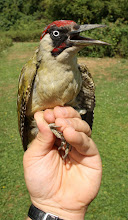
Above: Collared Pratincole (Canastera). We were told a road going west from Campo Lugar would be good for bird species. Upon arrival we met Spanish Birder - Antonio Calvo. My dad being fluent in Spanish got talking to him and soon he was showing us where to see the Collared Pratincoles on the ground.
Apparently they like ploughed, fallow fields. Not really knowing where we were or weren't allowed to stray off the roads to view birds, it was nice to have somebody who knew.

Above: A flock of about 50 Collared Pratincoles. I'd already seen a couple of singles and probably the same flock as above and suspected they were Collared Pratincoles but with Antonio's help, we got good views.
Whilst watching the Pratincoles, a nice adult male Montagu's Harrier passed through - the second and last one we saw during the holiday. I was too slow with the camera to get anything in focus.

Above: Great Bustard (Avutarda). Unfortunately, Antonio was only able to get us very distant views (ruined by heat haze) of this species, other than 2 birds in flight. It has been a bad year for birds in Extremadura with droughts lasting 2 years and much much reduced numbers of birds on migration. It has been hard to find even the resident species in great numbers. Antonio will be greatly relieved to know shorly after leaving him, we found this individual.
Antonio is starting his own accomodation/bird guide business. For those of you who can speak Spanish and would like some eco-friendly (walking) bird tours of Extremadura, visit his web site http://www.elelanio.com/ (you can read in Spanish or English).

Above & below: Gull-billed Tern (Pagaza piconegra). I find some Tern species difficult to distinguish between - especially at a distance. However, this Gull-billed Tern came quite close whilst I was standing on a bridge and you can see from the photograph it is has an all black bill (short & stout) and a black bar along the ends of the primary feathers - these are the identification features. It's call - remarkably non-tern like also gave it away.
This was a species on the 'want to see' list for the holiday and if it weren't for this one stop at the bridge I wouldn't have been able to say I'd seen one. I'd seen 4 Tern's previously at Merida but too distant to ID.

We went to many lakes/reservoirs in Extremadura but found very little in the way of water birds (e.g. ducks etc.). They can be awash with birds during the winter and very worth visiting, but apparently not during the spring/summer. More interest came from the surrounding habitat (although there were very few reed beds at all).

Above: Black Wheatear (Collalba negra). Not being able to get close enough for a good photograph (it consistantly stayed out of range for a good photo - normal behaviour I'm told!) I was delighted with being able to add it to the seen list.




No comments:
Post a Comment